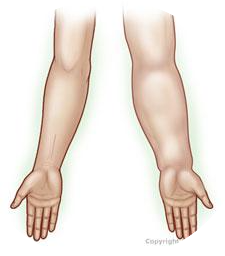Your lymphatic system is part of your body’s immune system. Its network of tissues, vessels, and organs carries lymph fluid, nutrients, and waste materials between your body tissues and bloodstream to maintain a normal, healthy fluid balance .Sometimes, due to heredity, a medical condition, or traumatic injury, your lymphatic system stops working efficiently. Fluid builds up in your tissues, causing swelling and discomfort. This condition is called lymphedema.
COMMON STAGES OF LYMPHEDEMA
Lymphedema is a chronic, progressive condition. That means it cannot be cured, and often gets worse over time. However, when identified early and treated consistently, lymphedema can be managed effectively at home.
Doctors have identified four common stages of lymphedema. You can be diagnosed and treated at any stage.
STAGE 0
You may not see swelling despite impaired lymphatic function. You may feel fatigue, pain, heaviness, tightness, or tingling in the affected area.
STAGE 1
You’ll see the Lymphedema swelling, but the area will return to normal size with rest, elevation, and/or compression. You may see some pitting of the skin, and when you apply pressure to the swollen area and release it, an indentation remains.
STAGE 2
In addition to lymphedema swelling, you start to see significant changes in the skin, as fibrosis, which is a hardening of tissue starts to develop. Your skin may also feel spongy.
STAGE 3
Tissue in the affected area will have hardened, and you may also see additional changes in your skin. The limb may be misshapen, large, and more swollen, and the risk of infection increases.
COMMON LYMPHEDEMA SYMPTOMS
Lymphedema typically appears with one or more of the following signs and symptoms depending on where the swelling occurs:
- Limb heaviness, aching, or fatigue
- Pitting edema, when skin is pressed, and the indentation doesn’t immediately disappear
- Swelling
- Decreased range of motion
- Inability to stand, walk, or move your body as normal.
- Skin hardening or scarring.
- Discolored, dry, or warm skin.
- Muscle weakness
- Slow-to-heal sores.
- Pain, discomfort, or tightness
You can take control of your lymphedema by using a Pneumatic Compression Device
provided by Total Compression Pumps. We will help you select the best device for
your symptoms and help you live a healthier lifestyle. We will gladly answer any questions.
Please call 800 854-0335.



